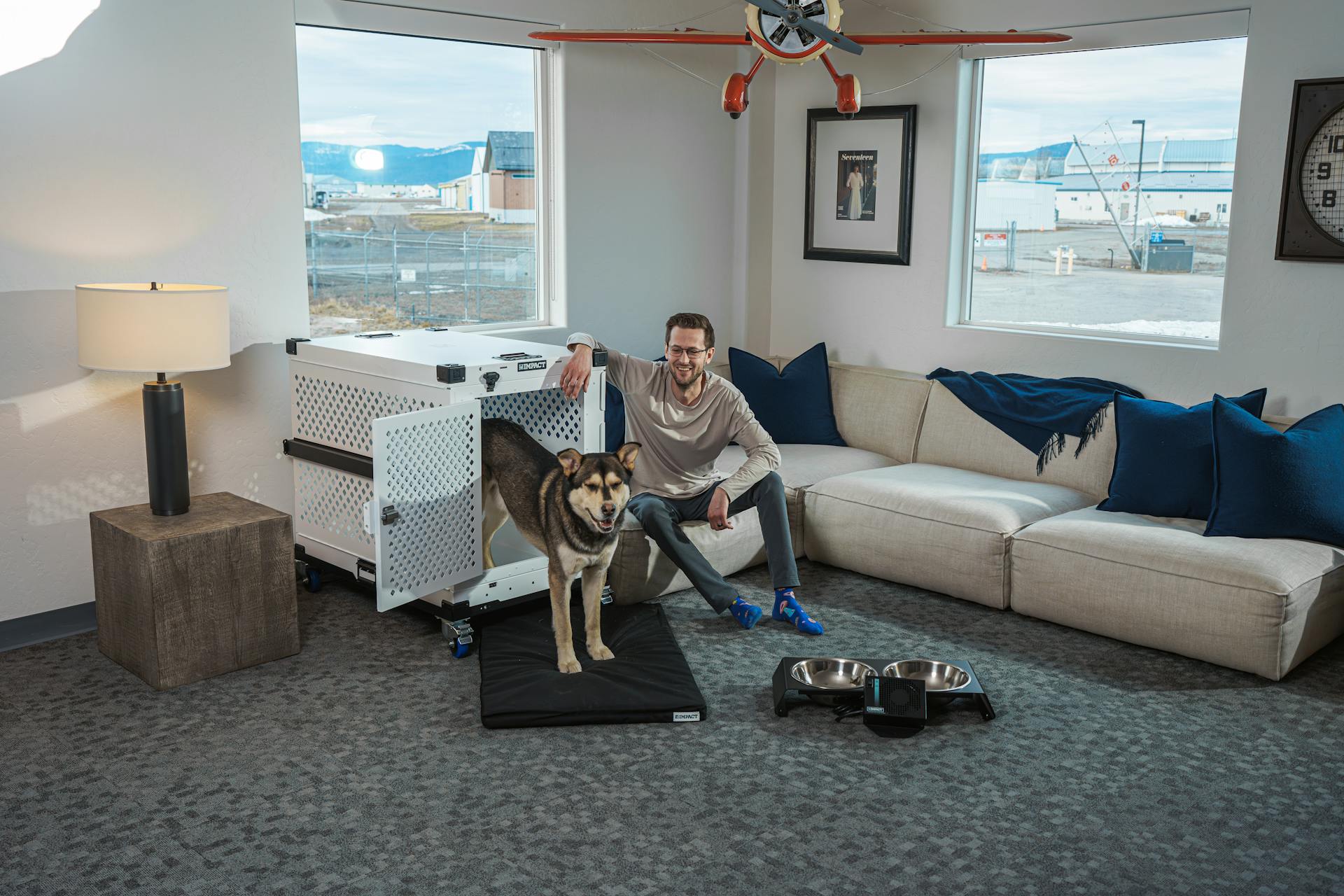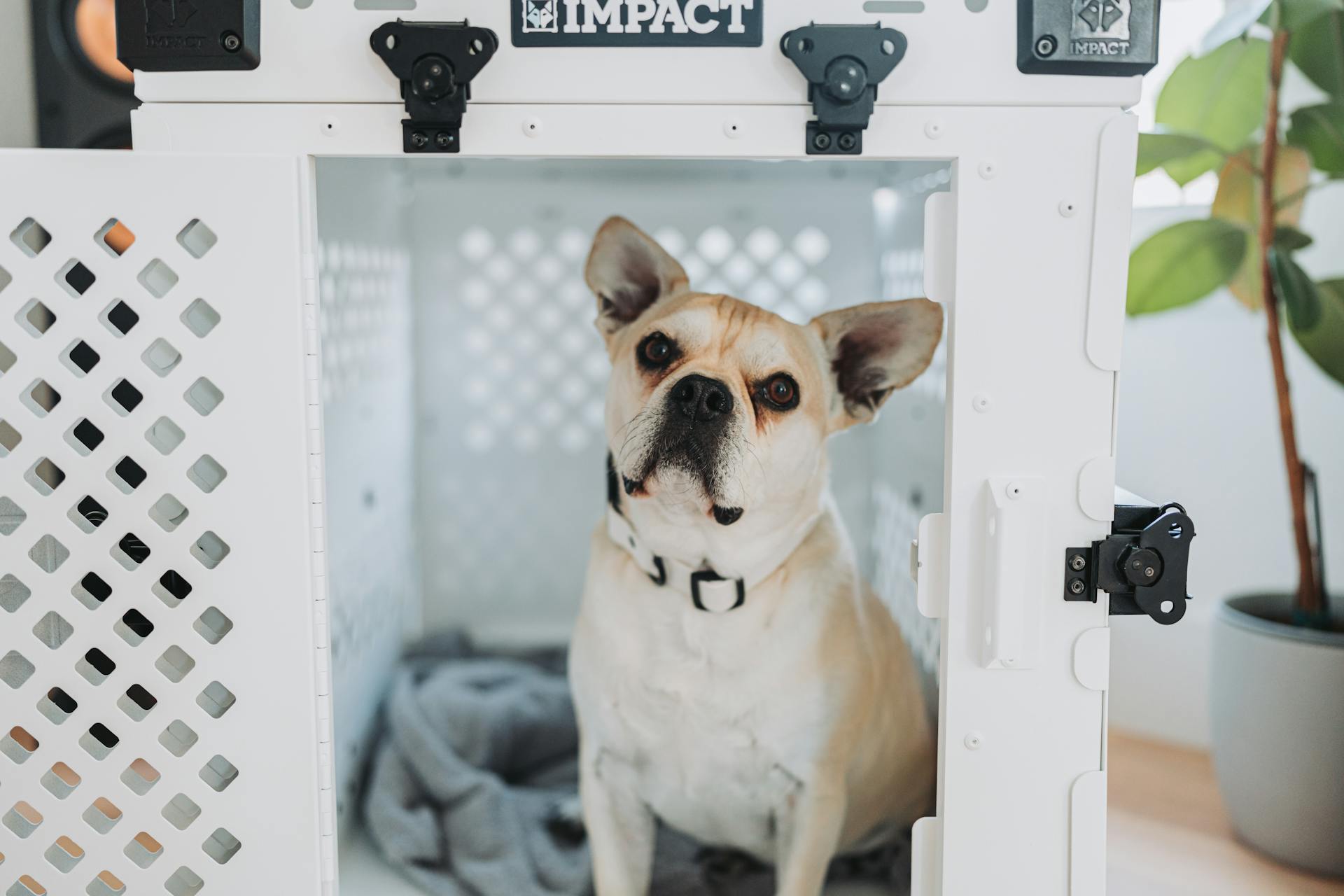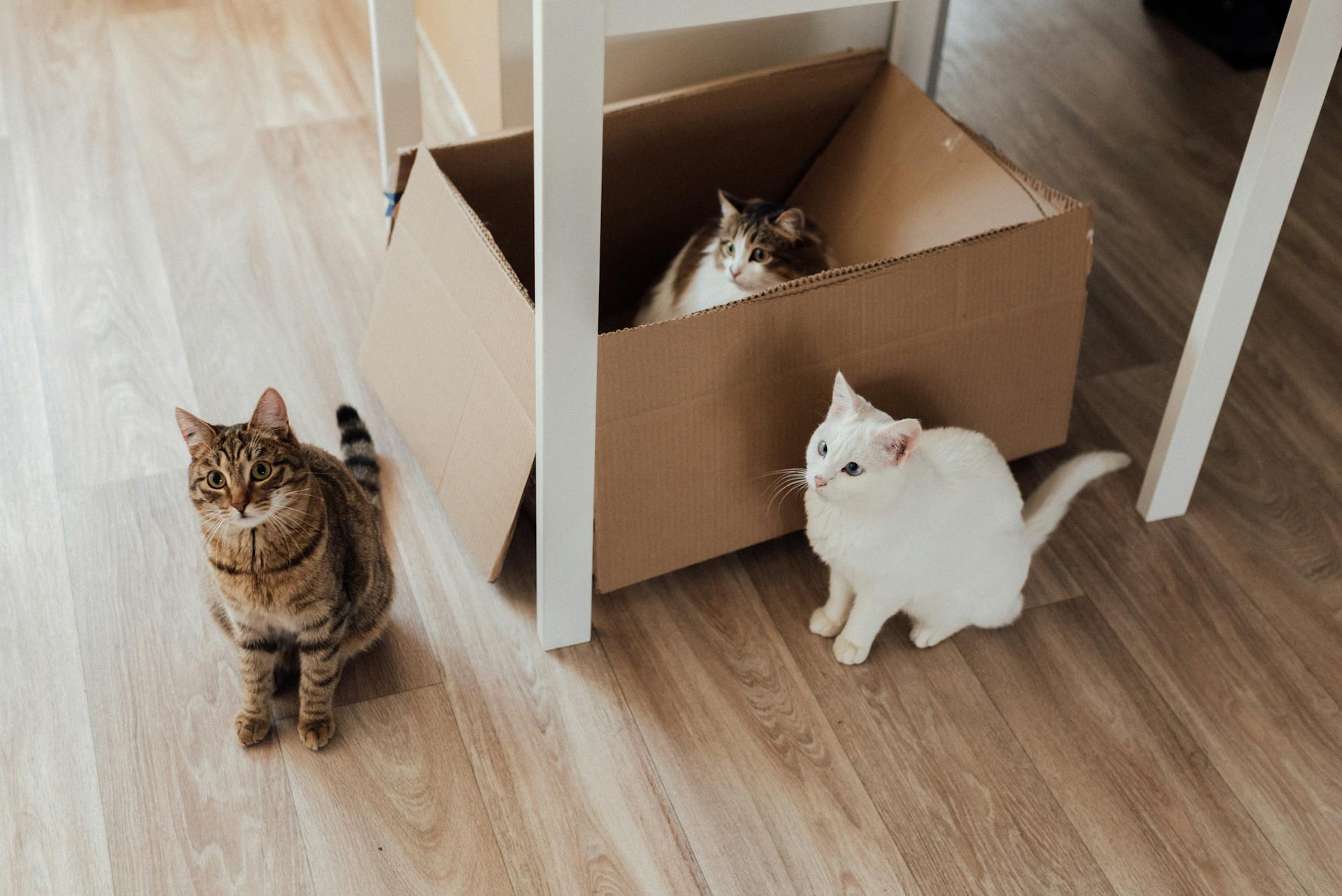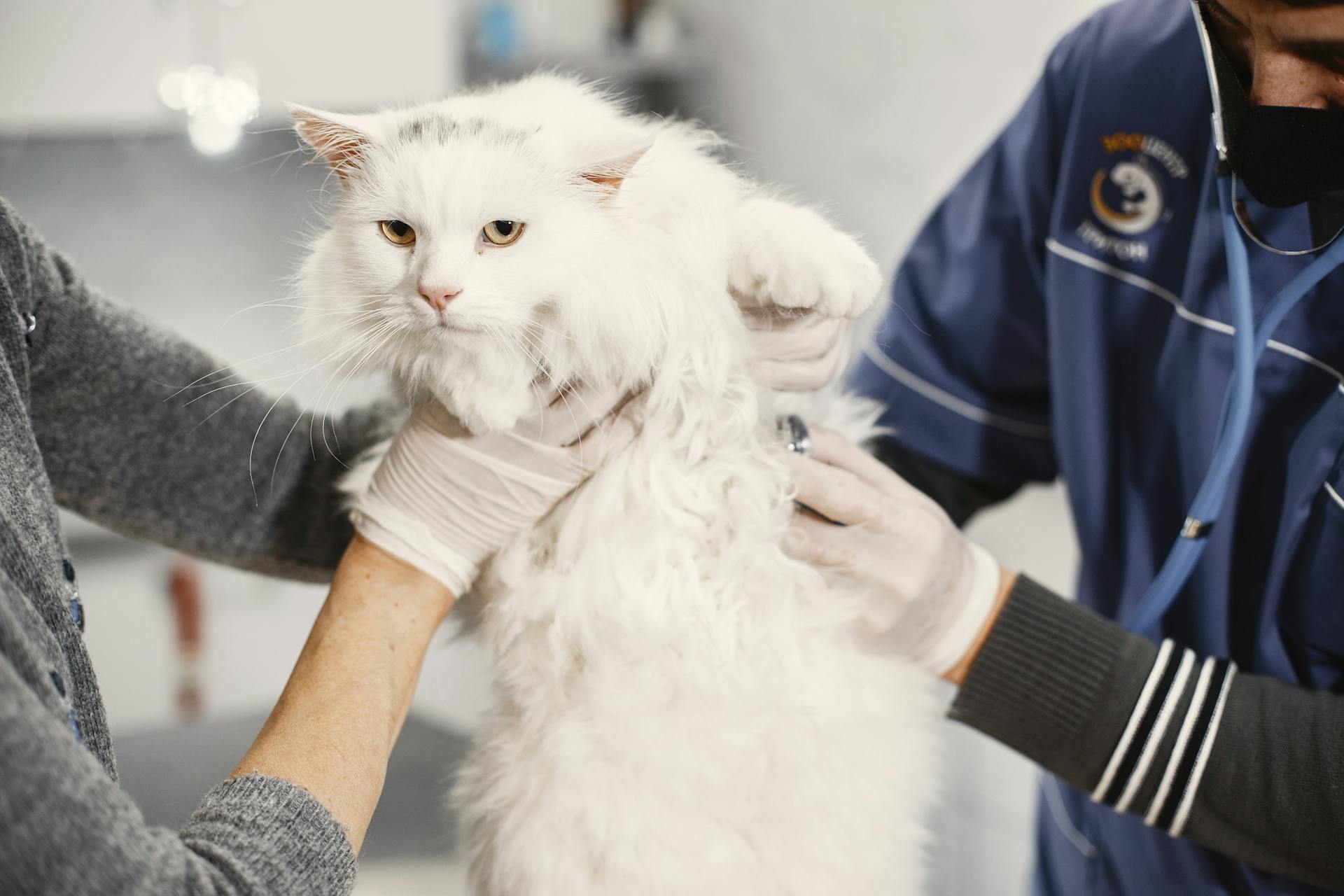
Crate training a cat can be a game-changer for many pet owners. By providing a safe and secure space, you can help your cat feel more relaxed and reduce the risk of destructive behavior.
Cats are naturally inclined to retreat to a small, enclosed space, known as a "hide box", which can be a crate. In fact, many cats will seek out a crate as a place to rest and feel secure.
To start crate training, it's essential to introduce the crate gradually, allowing your cat to become familiar with the new space. Begin by placing the crate in a high-traffic area with the door open, so your cat can explore it at their own pace.
A crate that's too large can be overwhelming for a cat, so it's crucial to choose one that's the right size for your cat. A crate that's about 2/3 to 3/4 the length of your cat is a good starting point.
Preparation
Cats are primarily motivated by food, so food plays a main role in the training process.
To reinforce your kitty's interest in the crate, prepare his/her favorite treats that will be used as a reward.
Prepare Cat Treats
To prepare your cat's favorite treats, remember that cats are primarily motivated by food. This plays a main role in the training process, so it's essential to use their favorite treats as rewards.
You can try preparing a variety of treats to keep things interesting and prevent boredom. Cats have unique preferences, so it's a good idea to observe your cat's favorite snacks and prepare those specifically.
Here are some tips for preparing cat treats:
- Identify your cat's favorite treats and prepare those specifically.
- Consider preparing a variety of treats to keep things interesting and prevent boredom.
Cats love food, so using their favorite treats as rewards will help reinforce their interest in the crate.
Chose the Right
Choosing the right carrier for your cat is crucial for their comfort and safety. A proper size crate allows your cat to lie down, stand up, and turn around without feeling cramped.

A crate with a removable top is a great feature as it makes veterinarian checks less stressful for your cat. It also provides a second exit option, making your cat feel more comfortable.
Soft-sided carriers are cozier and can be folded for easier storage. They're also lighter and easier to carry, making them ideal for travel.
However, soft-sided carriers are less durable and may not protect your cat as much as a hard-sided carrier. Your cat might even be able to escape if they become overly excited or anxious.
Hard-sided carriers, on the other hand, provide better protection and prevent escape. They're a great option for cats that need a secure and safe space.
Several repetitions around the crate can motivate your cat to spend more time around it or even inside it. This can help them get comfortable with the carrier before a trip or vet visit.
Familiarity
Building familiarity with your cat's travel crate is key to making the crate training process a success. This means introducing the crate gradually and making it a comfortable space for your cat.
Start by placing the crate in an area where your cat spends a lot of time, such as the living room or bedroom. Place treats, toys, and comfortable bedding inside the crate to encourage your cat to investigate.Make the crate cozy by adding soft bedding, familiar blankets, and toys.Consider placing a piece of clothing that smells like you inside the crate to make your cat feel more at ease.
By doing this, you'll help your cat become comfortable with the sight and smell of the crate, making the transition to actual crate training much smoother.
Training Methods
To get your cat comfortable with the crate, consider using clicker training. Click the clicker to mark the behavior and reward your cat with treats or favorite toys when they approach, sniff, or enter the crate.
It's essential to never rush the training process. Your cat may need more time to feel comfortable inside the crate, so be patient and repeat the sessions later when they're calm.
To encourage your cat to enter the crate, you can place several treats inside. Make sure to reward your cat with treats every step of the way, especially during car rides, to associate the crate with positive experiences.
Try Clicker Training
Clicker training is a great way to get your cat interested in the crate. This method works by associating the crate with positive experiences.
To start, review how to "load the clicker" and locate the training treats for spur of the moment sessions. The more you practice, the better your pet cat will become at hanging out near or even inside the crate.
Notice when your kitty shows interest in the crate, such as looking at it, sniffing around, or approaching it. Click the clicker to mark the behavior and immediately give your cat a reward.
The more positive experience you provide your cat with when he/she shows interest in the crate, the more motivated he/she will feel to keep doing it. This is why it's essential to reward your cat immediately after clicking.
Train Your Cat
Training your cat requires patience and a gentle approach. Choose a crate that's large enough for your cat to stand up, turn around, and lie down comfortably.
To crate train your cat, you'll need to make the crate an inviting place. Add soft bedding, treats, and even catnip to make it appealing. If your cat likes to nap or groom in the crate, you're on the right track.
The key to successful crate training is a slow desensitization process. Start by having your cat hang out outside the crate, then gradually move them inside with the door open, and eventually close the door. Reward your cat with treats and praise for calm behavior.
Don't rush the process if your cat shows signs of stress or anxiety. Back up and slow down to avoid creating a negative association with the crate. If your cat doesn't seem interested, try placing treats inside the crate to encourage them.
Here are some steps to follow:
- Call your cat by name and place a treat next to them
- Move the treat closer to the crate each time you call your cat
- Place a treat just inside the crate and step away
- Gradually increase the time your cat spends in the crate
Remember, every cat is different, so be patient and adjust your approach as needed. With time and consistency, your cat will learn to enjoy their crate and even see it as a safe space.
Build on Repetition
Repetition is key when crate training a cat. You'll want to repeat the same steps multiple times each day to help your cat become comfortable with the crate.
Try calling your cat by name, placing a treat next to them, and then moving the treat closer to the crate each time you call them. This exercise should be done multiple times a day until your cat becomes comfortable with the crate. If your cat isn't using the crate, try this exercise multiple times each day.
To make crate training more effective, reward your cat with treats each time they calmly progress through a step. If they show signs of stress or anxiousness, back up and slow down. Take a look at our article on How to Get Your Cat into Their Carrier for step-by-step instructions.
Here's a simple plan to follow:
- Call your cat by name and place a treat next to them
- Move the treat closer to the crate each time you call them
- Place a treat just inside the crate and step away
- Gradually increase the amount of time the door is closed
Carrier Training
Carrier training is a crucial part of crate training a cat. You'll want to start by choosing a carrier that's the right size for your cat, as mentioned in Example 4. This will ensure your cat has enough room to stand up, turn around, and lie down comfortably.
To make the carrier inviting, add soft bedding and treats inside, as suggested in Example 1. You can also try adding catnip or a small catnip toy to entice your cat. If your cat likes to nap or groom in the carrier, you know you're on the right track.
Desensitization is key to carrier training, as explained in Example 2. Start by letting your cat get used to the carrier by sitting outside it with the door open. Gradually close the door and extend the time the door is closed, always rewarding your cat with treats for calm behavior.
Remember to never rush the process, as mentioned in Example 5. If your cat shows signs of stress or anxiety, stop the session and try again when they're calm. You can also try placing treats inside the carrier to encourage your cat to enter voluntarily.
Here are some steps to follow when closing the carrier door for the first time:
1. Wait for your cat to show comfort near or inside the carrier.
2. Shut the door and keep it closed for a few seconds.
3. Reward your cat with treats and praise when they exit calmly.
By following these steps and being patient, you can help your cat associate the carrier with a safe and comfortable space.
Tips and Considerations
Don't rush the training process - your cat may need more time to feel comfortable inside the crate. If they start getting anxious, stop the session and repeat it later when they're calm.
Punishing your cat or forcing them into the crate will only create a negative association. Instead, try placing treats inside to entice them in.
Taking your cat for rides to different locations can also help them understand that car rides aren't just for vet visits.
Problems and Proofing
Don't rush the training process, as expecting immediate results can lead to frustration for both you and your cat. Give your cat plenty of time to adjust to the crate, and be prepared to pause on certain steps of the training process for a week or two.
A common mistake is to only associate the crate with negative experiences, such as trips to the vet or groomer. Try moving the carrier from room to room without leaving the house to help your cat become more comfortable with it.

If your cat has had bad associations with the crate, it may take time for them to change their behavior. Be patient and don't expect your cat to suddenly love the crate.
You can try swapping the crate for a different container, such as a soft carrier or a bigger crate, to see if that makes a difference.
Key Points to Keep in Mind During Training
Don't rush the training process. Your cat may need more time to feel comfortable in the crate, so be patient and give them the time they need.
Never punish your cat for not wanting to go into the crate. This will only create a negative association with the crate and make the training process more difficult.
If your cat is showing signs of stress or anxiety, it's a sign that you're moving too fast, so back up and slow down.
You should never give up on training, even if your cat is older and has had bad associations with the crate in the past. With time and patience, they can learn to accept the crate.

Make sure to reward your cat with treats and praise when they calmly progress through each step of the training process.
Here are some key things to keep in mind during the training process:
If your cat still isn't going into the crate, try changing the location or using a different crate design.
Why to Train Your Cat
Training your cat is essential because it helps prevent behavioral problems like scratching furniture, which can be a costly and frustrating issue for cat owners.
Cats that aren't trained can develop destructive behaviors like scratching furniture, which can cost up to $1,000 to replace.
Training your cat can also help prevent health problems, such as obesity, which is a common issue in indoor cats that don't get enough exercise.
A study found that indoor cats that don't get enough exercise are more likely to become overweight, which can lead to serious health issues.
By training your cat, you can also strengthen your bond with your pet, which can lead to a more loving and affectionate relationship.
Cats that are trained and socialized from an early age tend to be more confident and calm, making them a joy to be around.
Frequently Asked Questions
Is it okay to crate a cat at night?
Yes, crating a cat at night can be a safe and helpful solution for cats who need a secure space to sleep, especially during the transition to a new home or when litter box training is in progress.
How long can a cat stay in a crate?
Cats should not stay in a crate for more than 6 hours at a time to prevent negative effects on their mental health. Prolonged crate time can lead to anxiety and stress in cats.
How do you train a cat to sleep in a crate?
To crate train a cat, start by providing a spacious crate with comfortable bedding and treats, then gradually introduce it as a cozy sleeping space. As your cat becomes accustomed to the crate, you can close it at night to help them learn to sleep safely and soundly.
Is it okay to crate train a kitten?
Yes, crate training can start at any age, but starting early makes training easier for kittens
Sources
- https://resources.bestfriends.org/article/cat-crate-training-instructions-and-tips
- https://www.thesprucepets.com/crate-training-cats-553959
- https://www.petrelocation.com/blog/post/pet-travel-preparation-tips-how-to-crate-train-your-cat
- https://www.zoetispetcare.com/blog/article/crate-train-cat
- https://www.servicedogtrainingschool.org/blog/how-crate-train-your-cat-day-and-night
Featured Images: pexels.com


